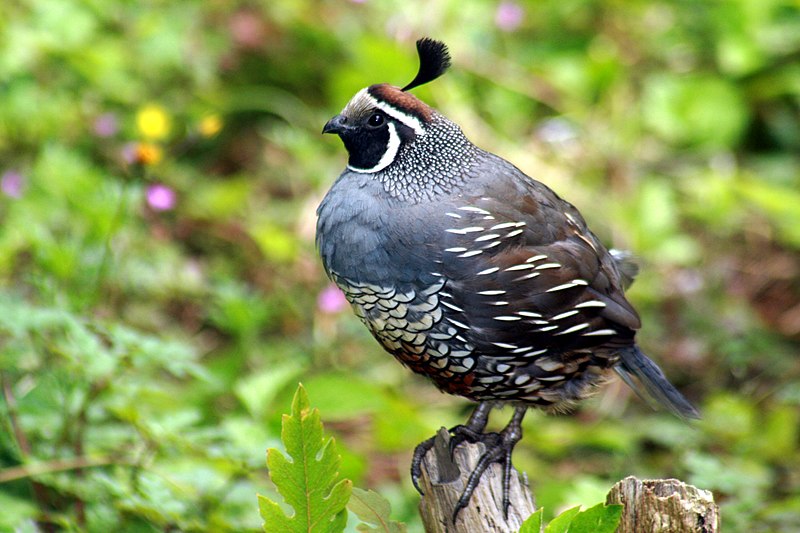
The California Quail ranges along the Western edge of North America, from Oregon to Northwestern Mexico. It reaches 10 inches in length but, like all quails, appears larger due to its stocky build. Captive bred birds are readily available.
Enclosure
California Quails are strictly birds for spacious, outdoor aviaries. Despite their relatively small size, they are extremely active and also like to perch well off the ground at night. California Quails dwell in some quite hostile habitats in the wild, but captives are intolerant of cold, damp conditions (wild birds move to high, dry areas during rainy weather). A warm, dry shelter is a must, even for those kept within their natural range.
The California Quail aviary should be heavily planted with tall grass clumps and shrubs. This will serve to calm nervous specimens, and insects attracted to the vegetation will keep them busy foraging all day long. An outside screen of evergreens is recommended, especially near roosting areas, as quails of all types are prone to “night frights” (at which time they may fly headlong into the aviary’s walls).
California Quails get along with finches, softbills and small parrots, but mated pairs will attack other quails during the breeding season.
Diet
Most quail keepers use a commercial quail or pheasant feed for their birds, while others prefer a mix of Dove Food and Canary Seed. Chopped kale, dandelion, romaine and other greens and native grasses should be offered each day, and grit must always be available.
Insects are taken frequently in the wild – live crickets, mealworms, waxworms and canned insects should be a regular part of the diet. Live plants will encourage insects to enter the aviary; the Zoo Med Bug Napper insect trap is an excellent (and interesting!) means of collecting live food for your quails.
Further Reading
 You can read about this bird’s natural history on the website of the Cornell Laboratory of Ornithology.
You can read about this bird’s natural history on the website of the Cornell Laboratory of Ornithology.
This video shows a fine male California Quail calling in the wild.
In Part II of this article we’ll learn about breeding this prolific (as in “40 eggs per hen per season”!) bird and have a look at the closely related Gambel’s Quail.
California Quail image referenced from wikipedia and originally posted by Mila Zinkova/Mbz1
California Quail chick image referenced from wikipedia and originally posted by Tony Wills
 That Bird Blog – Bird Care and History for Pet Birds
That Bird Blog – Bird Care and History for Pet Birds




I sure hope I can get some help with this problem. I have been hatching California valley quail. I am having a problem & don’t know how to fix it.The eggs hatch fine. The babies do fine for 2 or 3 days & than they die. They eat & drink fine. I cant figure what is wrong or how to fix it. The other quail do just fine. Bob white & snowflake. Please help me.
Thank you
John Sitek
Hello John,
Unfprtunatly its not possible to hazard a guess…sounds like something genetic perhaps, a problem in the line, as you are experienced and are not seeing obvious symptoms. If the supplier of the adults is not able to offr any info, an autopsy and related tests by an experienced avian vet would be your best option/. Sorry I could not be of more help, Frank
Hi John, I have come across this problem on occasion and in my experience it was diet related. If the protein content of the food is too low, they appear to do fine, but actually don’t gain weight and die. Some varieties like the Coturornix do fine fine on a poultry starter, but the game birds don’t. Just a thought – have no idea what you are currently feeding them.
Good luck.
Paul from Cape Town.
Hi Frank, My son rescued an abandoned baby quail chick around June/July of last yr. We have cared for it and she is loved by our family now, she has a large cage that is currently in the garage. I open the garage often & a wild male keeps visiting! It’s breeding season i belive and it’s clear that’s what’s on their minds. Since he’s been so persistent I’ve let him in with her. What do you think about keeping them as a pair? Or do you think it’s possible the baby chick we rescued would survive in the wild if we let her loose with this male? Do you think she will incubate the eggs if she lays? Just wondering what your thoughts were?
Hi Diana,
Unfortunately there are no sure answers to your questions…a wild male might not adjust well to captivity unless provided a huge enclosure. The female may do fine in the wild, as much instinct is involved, but would be at a disadvantage in many ways – physical and behavioral attributes that are undeveloped, etc. nesting is mainly instinctual, so she may incubate if they mate…sorry I could not provide more certain answers…very interesting situation, please keep me posted, best, frank